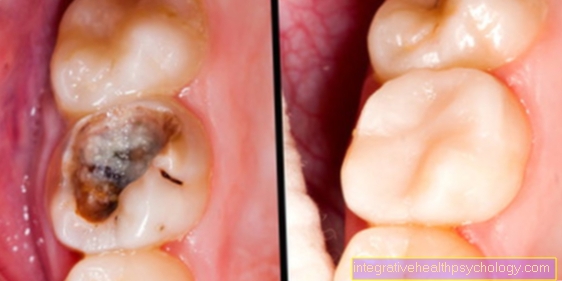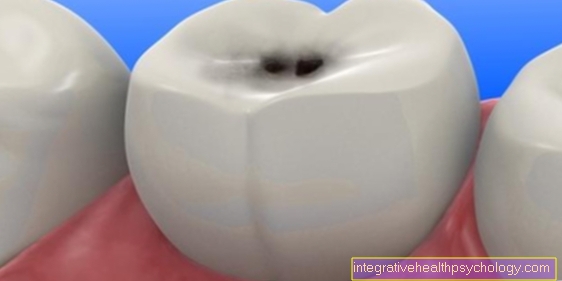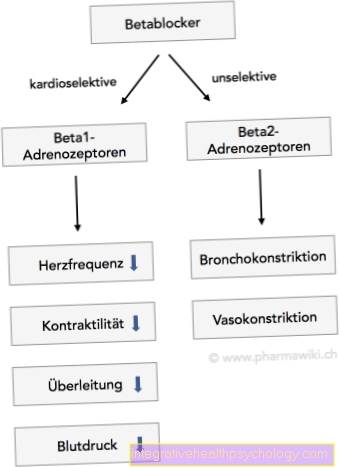Tooth neck filling
introduction
In dentistry, a tooth neck filling is a filling in the area of the tooth neck for the treatment of defects in the hard tooth substances (tooth enamel and dentin) at this point. The tooth neck filling is suitable for the treatment of small to medium-sized "holes" in the area of the tooth neck, which are mostly caused by caries or by incorrect tooth brushing technique.
Read more here: Cervical caries

The tooth neck filling serves not only to treat defects in the hard tooth structure, but also to prevent the (renewed) occurrence of caries and pain sensitivity in the tooth necks. In contrast to a root canal treatment, a filling on the neck of the tooth is a relatively painless treatment option, to preserve damaged teeth. A tooth neck filling can, depending on the material and with good oral hygiene hold for several years.
Procedure of a tooth neck filling
After the inspection has been completed and the dentist has informed the patient about the treatment, he first begins to remove the defective hard tooth substances (enamel / dentine) with rotating instruments (drills) or with hand instruments. This treatment step can be carried out under anesthesia (local anesthesia), which means that the treatment is painless for the patient. With the help of special probes, the dentist can check whether the diseased tissue has been completely removed, because a tooth neck filling may only be placed in healthy, caries-free tooth structures.
Before the actual filling begins, the tooth to be treated must be dried out because most of the materials in a tooth neck filling require a dry environment. In the best case, this is done with a rubber dam, if this is not possible, cotton rolls are inserted into the oral cavity, which absorbs saliva.
Depending on the type of filling material used, the tooth to be treated or the hard tooth substance to be treated is now prepared or conditioned for the placement of the tooth neck filling. This can include one to three work steps. In the case of composites (plastic), this is necessary to achieve a firm connection between the filling material and the tooth. The area to be filled is first etched with dilute acid, then an adhesive or bond is applied as a bonding agent and cured with a UV lamp.
Then composite is applied in thin layers, modeled according to the shape of the tooth and also cured under UV light. Once the filling is in place, protrusions are removed with the help of special drills and the tooth neck filling is polished to prevent food residues from sticking. A fluoridation of the treated tooth (e.g. with Elmex Gelee®) completes the tooth neck filling.
You can find out more about composite filling (plastic filling) here.
The tightness of the filling margins and the integrity of the tooth neck filling should be checked as part of the annual or half-yearly dental check-up.
Is a neck filling painful?
The tooth neck filling represents a relatively painless Kind of treatment of defects in the area of the tooth neck. In comparison to a root canal treatment, which can be very painful despite anesthesia, the Numbing the tooth not expecting pain with the help of a local anesthetic.
Frequently is also done no local anesthesia necessarywhen the "hole" is very small and does not require a lot of drilling.
Since the Tooth neck, due to its close spatial relationship to the main nerve of the tooth (pulp) sensitive to pain it can lead to slight, painful irritation of the tooth even after a tooth neck filling has been applied cold and warm dishes, as well as when enjoying cold and warm drinks come. However, compared to an untreated, exposed defective tooth neck, these are minimal.
You might also be interested in: Sensitive tooth necks
Cost of a tooth neck filling
The cost of a tooth neck filling vary depending on the effort (number of teeth to be treated), according to Size of the tooth defect, to Insured status of the patient, as well as according to the type of dental used Filling material.
The use of Composites As a filling material for the tooth neck filling, guarantees not only a longer durability but also a better aesthetic result of the tooth neck filling, since the plastic is available in tooth colors. This variant of the supply is used by the statutory health insurance companies but when aesthetic performance classified and must therefore be paid for by the patient himself or herself at least partially paid for myself (patient's own contribution).
The patient's own contribution for a composite filling depends on the effort, the extent of the defect and the filling material used. Thus, the cost of a tooth neck filling varies from practice to practice. It is best to ask the dentist you trust about the cost of a tooth neck filling.
For the legally insured But there are also patients free alternatives for composite filling: one Cement filling is chalky white or gray and needs to be renewed after 12-18 months while amalgam looks gray-metallic and usually lasts as long as a plastic filling. The advantages and disadvantages of the different filling materials should be clarified with the dentist.
Privately insured Patients get that costs for the tooth neck filling refundedif this is in the Service catalog of the respective tariff is included.
Which materials are suitable for a tooth neck filling?
Various types of dental materials and fillers are available for the neck filling.
In the past you used cement - or Amalgam fillings to supply the tooth neck. These filling materials have been abandoned due to health risks (amalgam filling) and short-term durability (cement), although today (2017) these are still the standard treatments according to health insurance. See above under "Cost of a tooth neck filling".
Cements are now only as temporary fillings in use. (Ex: if the patient wants to whiten their teeth (Whitening), but the filling is to be done now, cement is a temporary solution, as plastic cannot be bleached. After the bleaching, the cement decant is removed and the composite color is selected according to the current bleached tooth color and used instead of the cement.)
More information can be found here: Cement filling
To a long-term durability, as well as a good aesthetic result are nowadays used as a filling material Composites used. The composites are special plastics to which fillers have been added. In contrast to an amalgam filling, composites are applied and modeled by hand in several layers. In the meantime, the layers are hardened using a UV lamp (multi-layer technology).
The larger the tooth defect in the area of the tooth neck, the more layers are necessary. The multi-layer application and the interim curing of the composite layers with the aid of a UV lamp reduce the shrinkage of the composite material. Thus, a very good fit and tightness between the tooth / tooth neck and the composite filling. In addition to the good durability, the composite filling impresses with a very good aesthetic result.
While plastic fillings tended to be discolored over time from tea or coffee, this is no longer the case with today's modern composites.
Requirement for the long durability a correctly placed composite filling is one good oral hygiene of the patient.
When is a tooth neck filling necessary?
There are many reasons for using a tooth neck filling:
- Caries is often responsible for "holes" in the tooth or tooth neck.
- A high degree of sensitivity to pain in the area of the exposed tooth necks can also make a tooth neck filling (which in this case acts more like a seal on the tooth neck) necessary.
- Cleaning trauma: Very often the wrong toothbrushing technique causes so-called "wedge-shaped defects". These are areas of missing tooth substance that are not caused by caries but by mechanical abrasion, in that the tooth neck is "scrubbed" back and forth with bristles that are too hard and with too much pressure.
Read more on the subject here Brush your teeth - this is how it works - Periodontitis or gingivitis: When the gums retract as a result of inflammation, the necks of the teeth are exposed and are sensitive to external stimuli (dietary acids, bacteria or incorrect tooth brushing).
- Bruxism: The especially nocturnal Grinding your teeth to compensate for stress leads to Removal of tooth substance. Depending on the bite and how long the patient has been "grinding and pressing", there are also substance defects in the neck of the tooth that have to be treated.
- Besides these mentioned factors, you can general diseases such as. Reflux or heartburn, as well as excessive consumption of nicotine and caffeine, make a tooth neck filling necessary.
When does a tooth neck filling have to be renewed?
At the Tooth neck is the tooth one very high mechanical stress exposed because in the area of the tooth neck while chewing strong vertical and horizontal forces act on this. This high forces can lead to the neck filling in parts or in whole breaks out and needs to be renewed. See also under: Tooth filling failed - what to do?
Of the Transition between tooth enamel (or dentine) and the Filling material is special susceptible For Caries and acids from food. That is why regular and correct tooth brushing is important in order to avoid so-called "Secondary caries" to prevent. As soon as tooth decay occurs, the tooth neck filling must be renewed.
Excessive consumption of nicotine and caffeine can also contribute to discoloration of the tooth neck filling and this due to a noticeable, visible Color change needs to be renewed. This problem only occurs with very old plastic fillings.
In principle, renewing a tooth neck filling is not a problem. The old, broken, or discolored Tooth neck filling using rotating instruments (dem drill) away and the area to be newly filled is prepared or conditioned to receive the new filling material. This is followed by the insertion, hardening and polishing of the filling on the tooth neck with the respective dental filling material (see also above under "Procedure of the tooth neck filling").
The basic requirement for the long shelf life of a tooth neck filling is in addition to the regular control the tooth neck filling by the dentist, one good oral hygiene of the patient, as well as renouncing excessive nicotine and caffeine consumption. If these conditions are met, the tooth neck filling can be retained for several years (up to 10).















.jpg)













